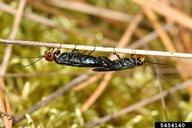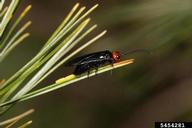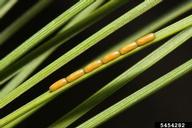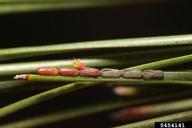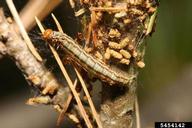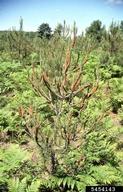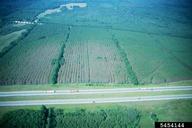Pine false webworm
Acantholyda erythrocephala (L.) (Hymenoptera: Pamphiliidae)
Orientation to pest
Pine false webworm, Acantholyda erythrocephala (L.), is an introduced pamphiliid sawfly of European origin that is now present in several parts of eastern North America and Canada. It feeds on several pines. Winter is passed as prepupae, which pupate in the spring. Adults emerge soon after and lay eggs in short rows of 3 to 10 in small slits cut into last year' needles. Young larvae spin loose webs in which they feed gregariously on old needles, which they cut off and then pull into the web to eat. Older larvae are solitary and feed from silken tubes bound to twigs. Frass and bits of needles stick to these silk tubes. When mature, larvae drop to the ground and build the earthen cells and overwinter as prepupae. Heavy infestations can defoliate hosts and cause tree mortality.
Hosts commonly attacked
This sawfly feeds especially on eastern white (Pinus strobus L.) and red (Pinus resinosa Sol. ex Aiton), but also Scotch (Pinus sylvestris L.), Austrian (Pinus nigra J.F. Arnold), and Japanese red (Pinus densiflora Siebold & Zucc.) pines.
Distribution
This sawfly is found in New England, New York, New Jersey, Pennsylvania, Wisconsin, Minnesota, Newfoundland, Alberta, Quebec, and Ontario.
Images of pine false webworm
| Figure 1. (Left) Adult (male: right; female: left) of pine false webworm, Acantholyda erythrocephala, in copula, and (right) adult female ovipositing on red pine foliage | Figure 2. Eggs of pine false webworm on red pine foliage |
| Figure 3. (Left) Neonate larva of pine false webworm emerging from the egg, and (right) ultimate instar larva climbing on silk strands outside the web | Figure 4. Damage (shoots with clipped off needles) by pine false webworm on young plantation-grown red pine | Figure 5. Defoliation in pine plantations in Simcoe Co., Ontario, due to pine false webworm |
Important biological control agents related to this pest species
Since this is an invasive species in North America, the parasitoids from its native range in Europe have been investigated for introduction. The most important such species is the tachinid Myxexoristops hertingi Mesnil, which has been released in Ontario, Canada.
Web links for information on pine false webworm
- Christmas Tree Fact Sheet | Ohio State University
- 1998 Article from NY Forest Owner | NY Department of Environmental Conservation
Discusses species' threat on New York's white pine - Fact Sheet | Natural Resources Canada
Articles
- Lyons, D. B. 1995. Pine false webworm, Acantholyda erythrocephala, pp. 245-251. In:. Armstrong, J. A and W. G. H. Ives (eds.). Forest Insect Pests in Canada. Natural Resources Canada, Canadian Forest Service, Ottawa.
- Kessel, C. 1998. The impact of the pine false webworm on the Ontario Christmas tree industry. In: Lyons, D. B., G. C. Jones, and T. A. Scarr (eds.). Proceedings of a workshop on the pine false webworm, Acantholyda erythrocephala (Hymenoptera: Pamphiliidae). University of Toronto, Toronto, Ontario, Canada, 16 February 1998.
- Asaro, C. and D. C Allen. 2001. History of a pine false webworm (Hymenoptera: Pamphiliidae) outbreak in northern New York. Canadian Journal of Forest Research 31: 181-185.
- Kenis, M. and K. Kloosterman. 2001. European parasitoids of the pine false webworm (Acantholyda erythrocephala [L.]) and their potential for biological control in North America, pp. 65-73. In: Liebhold, A. M., M. L. McManus, I. S. Otvos, S. L. C. Fosbroke (eds.). Proceedings of a conference entitled "Integrated management and dynamics of forest defoliating insects" held 1999 August 15-19, Victoria, British Columbia, and published as General Technical Report NE-277. U.S. Department of Agriculture, Forest Service, Northeastern Research Station, Newtown Square, Pennsylvania, USA. Viewable at http://iufro-archive.boku.ac.at/wu70307/victoria/kenis.pdf
- Lyons, D. B., M. Kenis, and R. S. Bourchier 2002. Acantholyda erythrocephala (L.), pine false webworm (Hymenoptera: Pamphiliidae ), pp. 22-28. In: Mason, P. G. and J. T. Huber (eds.). Biological Control Programmes in Canada, 1981-2000. CABI, Wallingford, UK.
